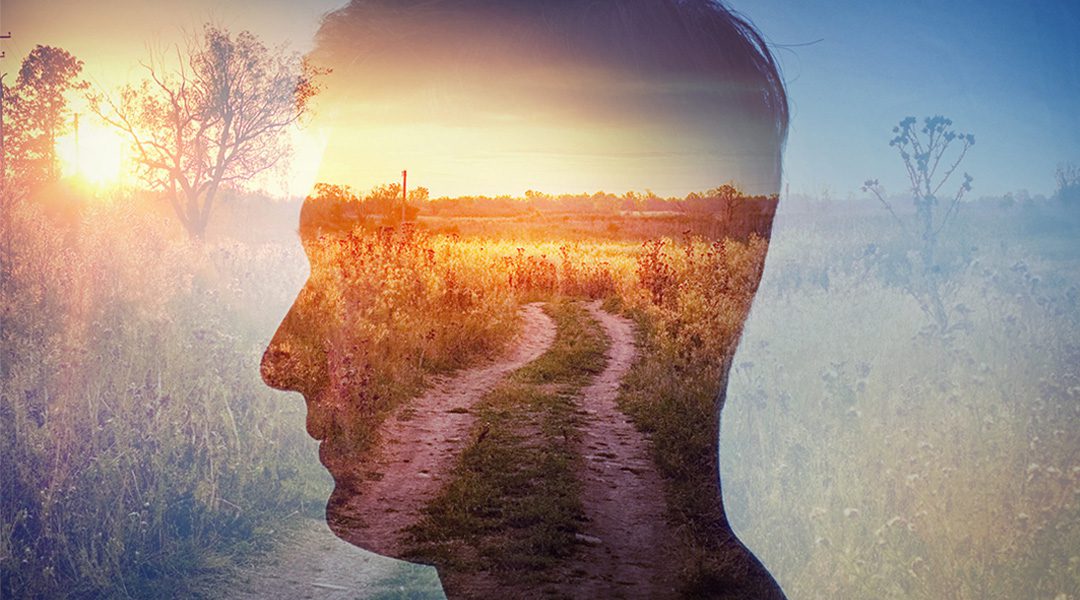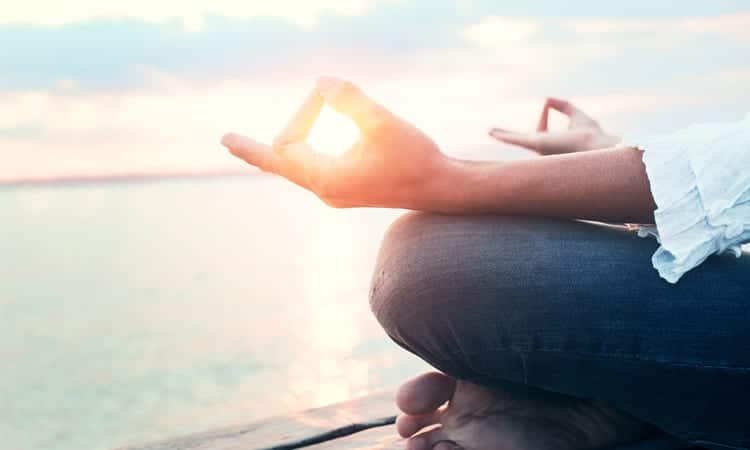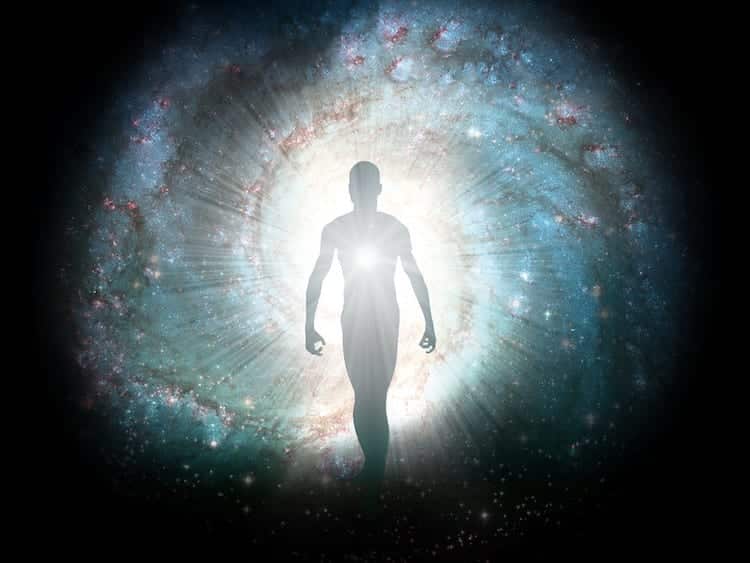We sat down with Paul Olko, a certified practitioner of Naturopathy, Chinese herbal medicine, and Tui Na acupressure massage, and a teacher of Taoism, Qigong, and Tai Chi. In the following interview, Paul drew some parallels between Taoist and yogic philosophy and explained the differences between Taoist movement arts and traditional Hatha Yoga.
The Unspoken Tao: An Interview with Paul Olko
The Tao that can be told is not the eternal Tao;
The name that can be named is not the eternal name.
The nameless is the beginning of heaven and earth.
The named is the mother of ten thousand things.
Ever desireless, one can see the mystery.
Ever desiring, one can see the manifestations.
These two spring from the same source but differ in name;
this appears as darkness.
Darkness within darkness.
The gate to all mystery.
Lao Tzu, in Tao Te Ching Ch. 1, as translated by Gia-Fu Feng & Jane English (1972)
How did you first get involved with the Taoist path?
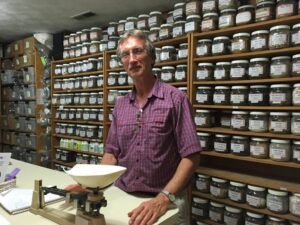
Paul Olko at the Green Lake Healing Center where he practices healing arts.
“After being a serious, long-term student of Yoga, I wanted to add onto my studies and practices. I was interested in Taoism, and the practice of Tai Chi interested me as well because it lends itself to being practiced outside easily.
I studied with Master Ni, also known as Hua Ching Ni. He was, in my personal opinion, playful yet forthright in his teaching, which I see as his way of being present. He is now known as OmNi.
Today, Master Ni’s sons Mao Shng Ni and Dao Shing NI have taken over and are the main teachers. Master Ni is still alive, but retired, as he is quite advanced in age. He doesn’t do any public teachings except on rare occasions. He does continue to write books on a regular basis. The College of the Tao is the organization that disseminates the teachings according to the Natural Way.”
What is Taoism, its teachings and its practices?
“Taoism is one the oldest belief systems in the world, and in fact it’s a spoke in the wheel of the Integral Yoga yantra. There are many different types or sects of Taoism, but there are 2 main branches: the monastic branch and the ancient natural way. The monastic branch of Taoist philosophy is characterized by the integration of more ceremony and monastic order. This branch developed as Buddhism started to work its way through China.
The Natural Way is not as formal. Taoist practitioners may be married and living naturally among the people. They may have regular jobs, but take part in Taoist practices. There are many different sects, but the tradition that I follow is the Natural Way as taught to me by the Ni family.
Taoism can be traced back to Lao Tzu, who put the teachings of Taoism down in verse format, kind of like the Yoga Sutras, in the Tao Te Ching. He did not invent Taoism, but he did share the teachings in writing. The main texts of Taoism are the Tao Te Ching and the I Ching.
Master Ni calls the Tao the Integral Way, which is funny because at Yogaville we practice Integral Yoga. The Tao, well… the Tao can’t be spoken of!” Paul laughs. “That’s the first verse in the Tao Te Ching! My interpretation of the Tao, however, is that it is the experience of being able to live in the ever-present moment—where past and future don’t even exist.
]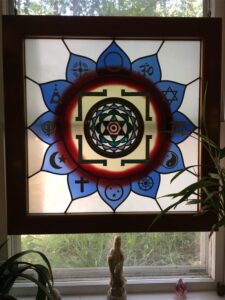
Taoism is represented by the Yin Yang symbol on the Integral Yoga Yantra.[/caption]
That concept is not too far from the goal of Yoga, really. The second verse of the Yoga Sutras states that ‘Stillness of the mind-stuff is Yoga’. If you’re present in the moment, that’s stillness. Immortality is the act of living in the moment. If you only exist in this moment, and this moment is ever-present, you are immortal. This stillness doesn’t only refer to the physical body, of course. The goal of Taoism is to be in harmony—to understand how we can be in harmony with nature. In fact, this goal of harmony with nature is the basis of Taoist and Chinese medicine. Both are based in energetics, and are guided by the principles of nature.”
How are the Taoist movement arts different from or similar to Yoga? What is Tai Chi, Qi Gong, and Taoist Yoga?
“Tao-yin (Taoist Yoga) means to harness your energy. It’s a little different than traditional Hatha Yoga. Some things about the practice are like Hatha Yoga, some things are like exercise, and there’s also some self-massage. There are stretches and movements combined with self-massage techniques, like massaging the ears or tapping the chest. Some movements are gentle and some are vigorous. Unlike Hatha Yoga, in Tao-yin we don’t hold the postures. Typically, you go into a pose, breathe, come out of a pose, and then go in again. The practice is more dynamic and flowing, but it’s all done on the floor, there are no standing poses. At the end there a series of hand meditation and affirmations.
Qi Gong is a practice of gentle movements and awareness intentions that also follows the principles of nature. It can be done more quickly if it is practiced early in the day or when it is cool, and it can be practiced more slowly at night, according to the natural principles. The first Qigong I introduce is the Eight Treasures.
Tai Chi itself is usually practiced for three possible reasons: martial arts, good health, or spiritual reasons. It is a practice that is similar to Yoga in that it is not a religion. There is a spiritual component and beliefs, but it can be practiced by anyone.
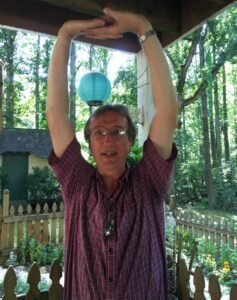
Paul demonstrates the movement to connect heaven and earth.
The workshop that I’ll be offering at Yogaville will provide exposure to the fundamentals of the philosophy and movements of Taoism. We’ll follow the cycles of nature, so we’ll be more physically active in the mornings.
We’ll also be doing a practice to do and live the Tao Te Ching; we’ll be doing movements that correspond to verses in the Tao Te Ching. So we’ll be breathing, living, and experiencing the wisdom of the Tao Te Ching in physical form besides study in the afternoon. The movements are all Tai Chi movements. One movement, for example, is the existence between heaven and earth.
So please join me in learning on how we exist as humans living between heaven and earth.”

